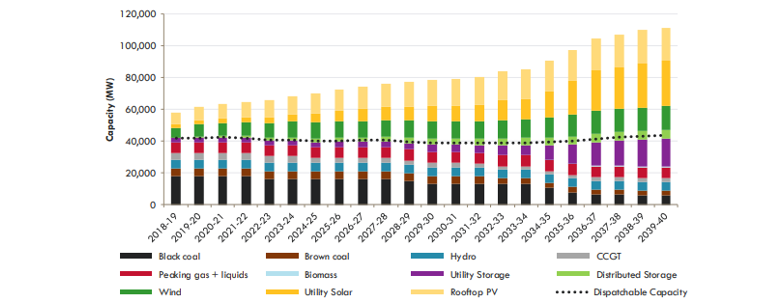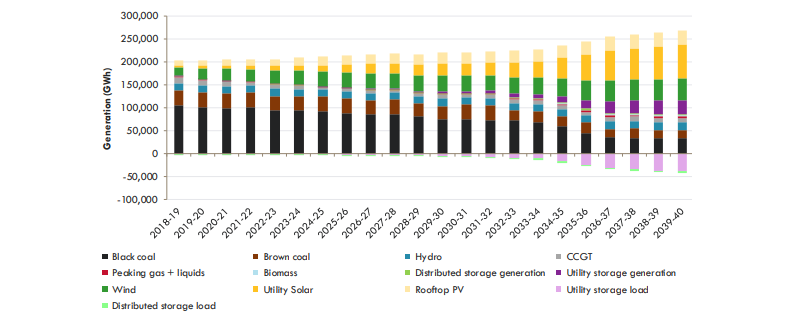 Over the past year, we have seen the misnamed report into “energy security” by Chief Scientist Finkel, the ACCC’s report (“restoring electricity affordability”) — and now a new annual report by market operator AEMO. These are in addition to a couple of dozen reviews into specific market-machinery matters and the regular reports from Code administrator AEMC, price and informational regulator AER, and AEMO.
Over the past year, we have seen the misnamed report into “energy security” by Chief Scientist Finkel, the ACCC’s report (“restoring electricity affordability”) — and now a new annual report by market operator AEMO. These are in addition to a couple of dozen reviews into specific market-machinery matters and the regular reports from Code administrator AEMC, price and informational regulator AER, and AEMO.
All these outputs derive from resources poured into government management of a sector to provide reports produced by people who are not participants in the actual supply and use of electricity. Ostensibly, the reports are trying to undo the mistakes made by the predecessors of those currently in the regulatory chairs and their political masters, mistakes that have needlessly doubled the cost and reduced the reliability of electricity. The market meddling, mainly the subsidising of renewables, has robbed Australia of its natural position as the home of the world’s cheapest power into the most expensive.
The latest AEMO report follows the now well-trodden path to disaster. It ostensibly offers a blueprint for what it regards as “the least-cost option for an orderly transition to renewables”. As AEMO chief Audrey Zibelman says, “We are witnessing disruption across almost every element of the value chain … Care must be taken now more than ever to manage this transformation in order to minimise costs and risks and maximise value to consumers”. But there is no discussion of this transformation being caused by subsidies, the latest encapsulated in the 26% emission reductions said to be required by the Paris Agreement.
Of course, borrowing the vocabulary of “disruption” that has given us Airbnb, eBay and Amazon totally mischaracterises the causes of the disaster in electricity supply. The disruption in electricity supply is an outcome solely due to regulatory intervention and not attributable to technological developments bringing new supply systems that out-compete existing providers.
Ms Zibelman describes AEMO’s report as providing a bridge to a future where renewables will triumph as the lowest-cost source of energy. A succession of future coal generator retirements is logged. There is no suggestion that new coal will be built, despite coal’s competitiveness being illustrated in the thousand-plus units under construction globally and the stated ambition of at least two significant players (Sunrise and Alinta) to build new capacity. Neglected is the ACCC’s call for government contractual support for new “firm” capacity (i.e. coal generators, though the ACCC’s conditions appear to rule out such support for Sunrise and Alinta). Nor does AEMO appear to take into consideration the sensible ACCC recommendation to terminate the roof-top solar subsidy.
AEMO modelling has the renewables share of capacity and generation at 50 per cent by 2030, in line with the ALP goals! Here is its model of generation over the coming years.
Share of generation capacity
Share of actual generation
Actually, in what the International Energy Agency’s green promoter Fatih Birol calls a “worrying trend”, global investment in renewables fell last year and is also down this year. Much of this is due to reduced subsidies, especially in China and doubts about future support elsewhere.
Though AEMO thinks the future is renewables it recognises their inherent unreliability will require an on-going component of coal-fired reliability, plus an ever-growing expansion of (customer-financed) transmission. The transmission expansion comprises three elements:
- Immediate action, including to increase transfer capacity between and within the states in the main caused by the growth of dispersed renewables and the “congestion” they are causing
- Future expansions to support the Renewable Energy Zones (REZ), 33 of which are identified, and the “strategic storage initiatives” of Snowy2 and batteries
- A further massive expansion of transmission after 2030 as the coal capacity is retired.
At least there is no longer talk about the early closure of coal-fired power stations to allow new wind and solar more room to enter the market – indeed, the concern is to prevent premature closures. But faith is pinned on the coming displacement of fossil fuel by renewables that – as has been the case for 35 years – are teetering on the brink of being lower cost. AEMO emphasis is on the attendant requirements for new transmission in light of the replacement of coal by wind, solar, pumped storage and batteries.
The report avoids specifying cost estimates for all this, limiting itself to “key observations” that envisage a benefit to consumers of $1.2 billion from the transmission developments it proposes. Although some of the REZs are said to have surplus transmission capacity, this paves the way to having the costs smeared across consumers’ bills, rather than being incorporated in the providers’ costs.
As the ad puts it, “That’s not what it says in the instructions, Harold”.
The Code, which the AEMO is ostensibly applying, calls for new transmission to be paid for by the beneficiary. If a new supply source enters the market, it and not the consumers should pay for any costs involved in getting the electricity to the customers.
So, winner-picking and subsidies to the Politically Correct renewables remains the order of the next three decades. Even with the heroic assumptions of an impending increase in renewables’ competitiveness, the market regulator recognises that they’ll still need a leg-up into the 2040s!
With all the reports available and the flexibility of the proposed National Energy Guarantee’s moveable carbon tax goals, we are nowhere near the regulatory certainty that is a supposed goal of all these models and strictures. We are even further removed from restoring Australia to having the world’s most successful energy industry.
Like dogs with a taste for worrying sheep, politicians are addicted to continuing their destructive interventions in energy supply. And they have created an endless supply of officials and vested interests who will tell them how they can vary those interventions but they have little stomach for disengaging and allowing the market the freedom to operate without regulations and guidance.
Alan Moran is from Regulation Economics. His latest book is CLIMATE CHANGE: Treaties and Policies in the Trump Era
 Sign In
Sign In 0 Items (
0 Items ( Search
Search











Yet again the result of a majority of the general populace resolutely choosing to remain both scientifically/engineeringly illiterate and mathematically innumerate shoves the entire nation down another step.
The multitudinous waffle entities now created as part of Australia’s Green Blob are almost uncountable. A careful reading of this week’s ACCC report (by our Rod) is contradicted in many aspects by this week’s AEMO report (by not-our Audrey). Few people will read these reports to understand that. These people, the political/bureaucratic/media morass, simply have no idea what they are doing; that they care not, as well, can be easily surmised . The genuinely despairing fact is that this situation is bipartisan, with only a minor degree separating the partisans. The one enduring aspect of wielding of power through the ages and across cultures is the utter refusal of those in power to admit they were wrong in any significant aspect. Moral vanity, conceit, noble cause corruption, hubris, plain greed (although generally hidden) … whatever.
I expect to see “warmest blah blah since Croesus was a boy” used as a rebuttal. Well, last week was the coldest week for Mt Erebus since Croesus’ great great grandaddy was a boy. Spot cherry picks are just propaganda, deliberately so.
Well said, ianl. May I quote Tolstoy? “I know that most men, including those at ease with problems of the greatest complexity, can seldom accept even the simplest and most obvious truth if it be such as would oblige them to admit the falsity of conclusions which they have delighted in explaining to colleagues, which they have proudly taught to others, and which they have woven, thread by thread, into the fabric of their lives”.
What is the motive for this journey back in time to windmills and sunshine?
The AGW farce is no longer even a fig leaf, so what could tbe real reason be for the destruction being wrought in every home and business in Australia ?
We are going to necessarily have ‘energy rich’ and ‘energy poor’, just as we do with IT. And it’s largely the Left which has brought this about. This needs to be remembered when the Left rants about caring for the disadvantaged. Over and over.
The chance of the NEG getting up, in its present form, is about zero. THE ACTU under its new militant CFMMEU leadership, more interested in virtue signalling than real jobs, will ensure that Labor will oppose it. Difficult to see how the States will line up but getting universal support from them also seems problematical. This farce will drag on until someone has the guts, and the numbers, to say enough is enough – we’re out of the Paris Agreement, renewables must stand on their own feet and no more CO2 emissions reduction targets. Yes, a very long time! I may not live to see the day.